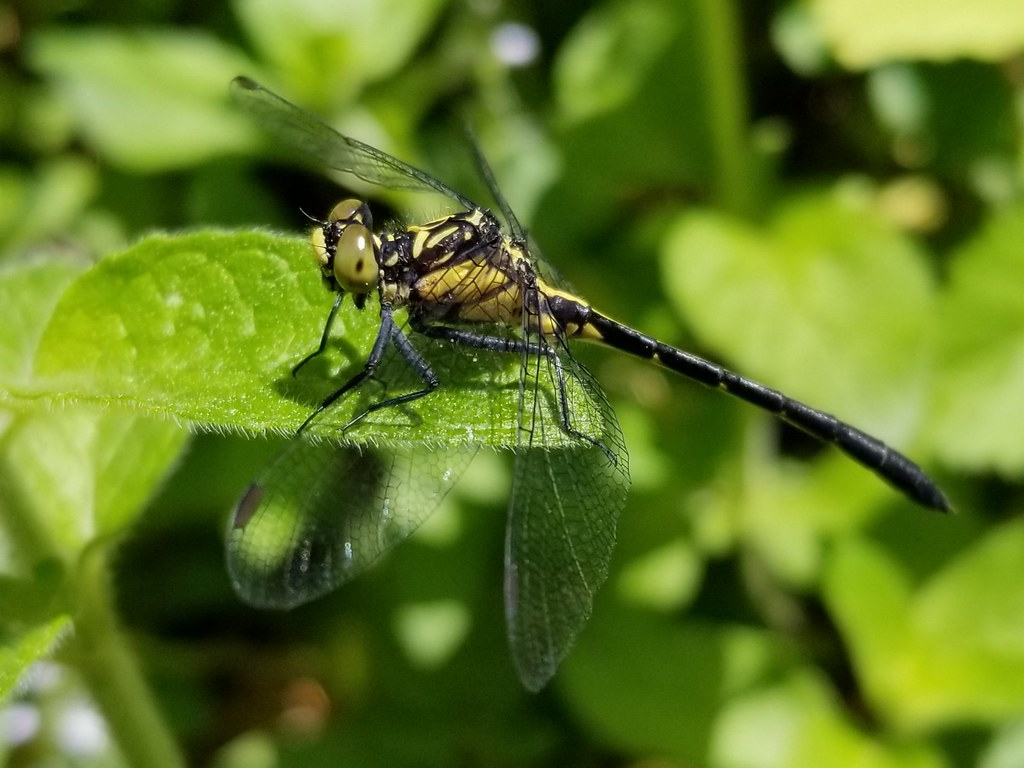DEP Scientist Finds and Photographs Extremely Rare Dragonfly Near Rondout Reservoir
July 22, 2019
Southern pygmy clubtail is “critically imperiled” in New York, only survives in cleanest waters
The New York City Department of Environmental Protection (DEP) today announced that one of its field ecologists discovered an extremely rare species of dragonfly living along a small tributary that feeds Rondout Reservoir in the Catskills. The dragonfly, known as the Southern pygmy clubtail, can only survive and reproduce in extremely clear, clean waters, making them an exceptional indicator of water quality. This particular species of dragonfly is considered critically imperiled in New York, and it is rare enough that many experts fear localized extinction in the few places where it is known to exist.
DEP scientist Frank Beres discovered the dragonfly during a short hike to a water-quality sampling site in the forest surrounding Rondout Reservoir. In addition to his work for DEP, Beres is a naturalist who has photographed and documented thousands of macroinvertebrates, insects, birds and other animals. After Beres spotted it, the Southern pygmy clubtail hopped on his finger and allowed him to take several excellent photos before flying off.
“One of the most exciting moments for an ecologist or naturalist in the field is the sighting of a rare species,” Beres wrote in a brief report about his encounter with the dragonfly. “This chance encounter with a rare, unique, secretive and delicate organism that requires a specific, pristine habitat emphasizes the ecological intricacies of the Catskills and the importance of all work performed to assess and protect lands and waters in the watershed.”
The Southern pygmy clubtail (Lanthus vernalis) originates from an ancient genus, Lanthus, that branched into three species more than 175 million years ago. Two of those three species live in New York. Its dwindling population in New York and the Northeast have been documented since 2000, and a five-year survey failed to find the dragonfly at half the New York sites where it was known to historically exist. As a result, the Southern pygmy clubtail was upgraded to “critically imperiled” by the New York Natural Heritage Program in 2012. That ranking describes species that are especially vulnerable to extirpation, or localized extinction, in New York due to their rarity, restricted range and habitat, or steep population decline.
The Southern pygmy clubtail is limited to pristine and rocky streams, groundwater-fed brooks, and seepages in forested areas. Its larvae are intolerant of excessive sedimentation, and therefore serve as excellent indicators of water quality. Because the species needs cold water to survive and thrive, this particular dragonfly and its larvae are also helpful in pinpointing waters that are suitable for brook trout. The adult pygmy clubtails, true to their name, only reach a size of about 4 centimeters. The adult clubtails are so secretive and rarely viewed that little is known about the species’ life, habits and population dynamics.
DEP scientists regularly collect macroinvertebrates and insects from streams in the watersheds that feed New York City’s reservoir system. The careful analysis of these stream-dwelling creatures can tell scientists a lot about water quality, as many of them can only survive in extremely clean and cold water. By tracking their presence over time, DEP can also understand trends in water quality at different locations throughout the watershed. The examination of macroinvertebrates and insects compliments a wider program of water quality monitoring that is performed by DEP every day of the year. In 2018, DEP scientists collected 53,200 samples of water from the watershed and sampling stations in the five boroughs of New York City. Those samples were analyzed 654,000 times for approximately 240 water quality parameters. A growing network of robotic monitoring instruments on the reservoirs provided another 1.3 million water-quality data points that were analyzed by scientists and engineers throughout the year to help operate the reservoir system.
DEP manages New York City’s water supply, providing more than 1 billion gallons of high-quality water each day to more than 9.6 million New Yorkers. This includes more than 70 upstate communities and institutions in Ulster, Orange, Putnam and Westchester counties who consume an average of 110 million total gallons of drinking water daily from New York City’s water supply system. This water comes from the Catskill, Delaware, and Croton watersheds that extend more than 125 miles from the City, and the system comprises 19 reservoirs, three controlled lakes, and numerous tunnels and aqueducts. DEP has nearly 6,000 employees, including almost 1,000 scientists, engineers, surveyors, watershed maintainers and other professionals in the watershed. In addition to its $70 million payroll and $168.9 million in annual taxes paid in upstate counties, DEP has invested more than $1.7 billion in watershed protection programs—including partnership organizations such as the Catskill Watershed Corporation and the Watershed Agricultural Council—that support sustainable farming practices, environmentally sensitive economic development, and local economic opportunity. In addition, DEP has a robust capital program with $20.1 billion in investments planned over the next decade that will create up to 3,000 construction-related jobs per year. For more information, visit nyc.gov/dep, like us on Facebook, or follow us on Twitter.





